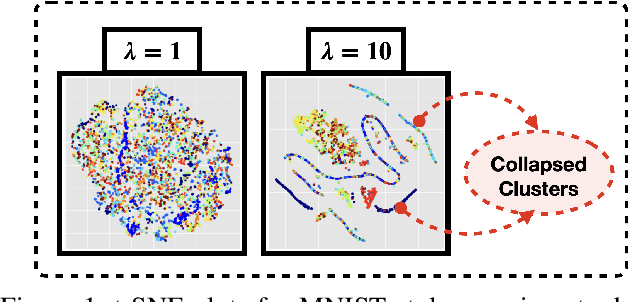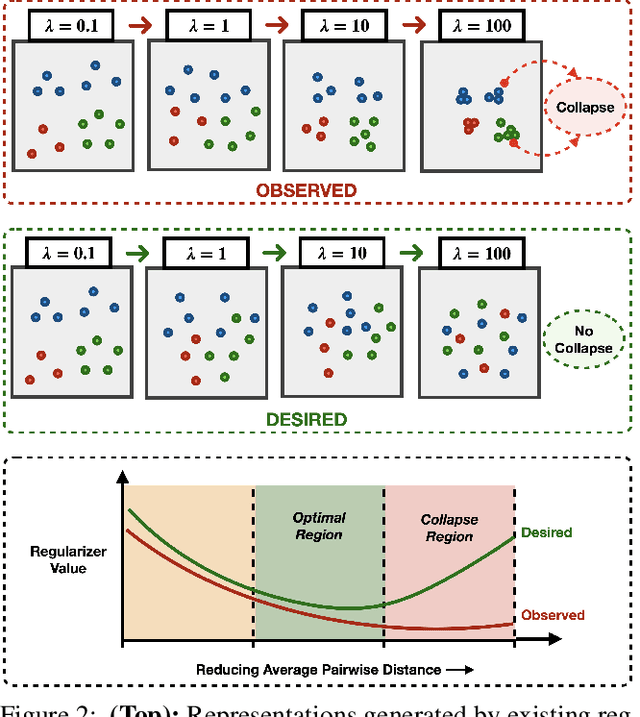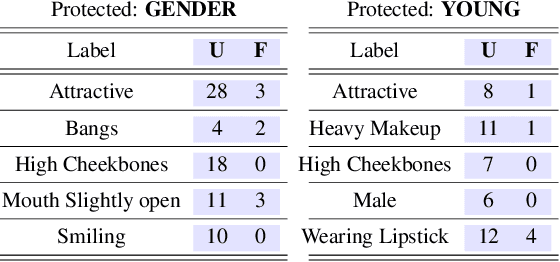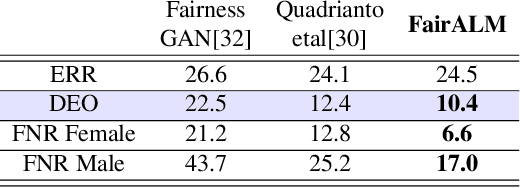Vishnu Suresh Lokhande
Your Text Encoder Can Be An Object-Level Watermarking Controller
Mar 15, 2025Abstract:Invisible watermarking of AI-generated images can help with copyright protection, enabling detection and identification of AI-generated media. In this work, we present a novel approach to watermark images of T2I Latent Diffusion Models (LDMs). By only fine-tuning text token embeddings $W_*$, we enable watermarking in selected objects or parts of the image, offering greater flexibility compared to traditional full-image watermarking. Our method leverages the text encoder's compatibility across various LDMs, allowing plug-and-play integration for different LDMs. Moreover, introducing the watermark early in the encoding stage improves robustness to adversarial perturbations in later stages of the pipeline. Our approach achieves $99\%$ bit accuracy ($48$ bits) with a $10^5 \times$ reduction in model parameters, enabling efficient watermarking.
Craft: Cross-modal Aligned Features Improve Robustness of Prompt Tuning
Jul 24, 2024



Abstract:Prompt Tuning has emerged as a prominent research paradigm for adapting vision-language models to various downstream tasks. However, recent research indicates that prompt tuning methods often lead to overfitting due to limited training samples. In this paper, we propose a Cross-modal Aligned Feature Tuning (Craft) method to address this issue. Cross-modal alignment is conducted by first selecting anchors from the alternative domain and deriving relative representations of the embeddings for the selected anchors. Optimizing for a feature alignment loss over anchor-aligned text and image modalities creates a more unified text-image common space. Overfitting in prompt tuning also deteriorates model performance on out-of-distribution samples. To further improve the prompt model's robustness, we propose minimizing Maximum Mean Discrepancy (MMD) over the anchor-aligned feature spaces to mitigate domain shift. The experiment on four different prompt tuning structures consistently shows the improvement of our method, with increases of up to $6.1\%$ in the Base-to-Novel generalization task, $5.8\%$ in the group robustness task, and $2.7\%$ in the out-of-distribution tasks. The code will be available at https://github.com/Jingchensun/Craft
MultiEdits: Simultaneous Multi-Aspect Editing with Text-to-Image Diffusion Models
Jun 03, 2024



Abstract:Text-driven image synthesis has made significant advancements with the development of diffusion models, transforming how visual content is generated from text prompts. Despite these advances, text-driven image editing, a key area in computer graphics, faces unique challenges. A major challenge is making simultaneous edits across multiple objects or attributes. Applying these methods sequentially for multi-aspect edits increases computational demands and efficiency losses. In this paper, we address these challenges with significant contributions. Our main contribution is the development of MultiEdits, a method that seamlessly manages simultaneous edits across multiple attributes. In contrast to previous approaches, MultiEdits not only preserves the quality of single attribute edits but also significantly improves the performance of multitasking edits. This is achieved through an innovative attention distribution mechanism and a multi-branch design that operates across several processing heads. Additionally, we introduce the PIE-Bench++ dataset, an expansion of the original PIE-Bench dataset, to better support evaluating image-editing tasks involving multiple objects and attributes simultaneously. This dataset is a benchmark for evaluating text-driven image editing methods in multifaceted scenarios. Dataset and code are available at https://mingzhenhuang.com/projects/MultiEdits.html.
Pooling Image Datasets With Multiple Covariate Shift and Imbalance
Mar 14, 2024Abstract:Small sample sizes are common in many disciplines, which necessitates pooling roughly similar datasets across multiple institutions to study weak but relevant associations between images and disease outcomes. Such data often manifest shift/imbalance in covariates (i.e., secondary non-imaging data). Controlling for such nuisance variables is common within standard statistical analysis, but the ideas do not directly apply to overparameterized models. Consequently, recent work has shown how strategies from invariant representation learning provides a meaningful starting point, but the current repertoire of methods is limited to accounting for shifts/imbalances in just a couple of covariates at a time. In this paper, we show how viewing this problem from the perspective of Category theory provides a simple and effective solution that completely avoids elaborate multi-stage training pipelines that would otherwise be needed. We show the effectiveness of this approach via extensive experiments on real datasets. Further, we discuss how this style of formulation offers a unified perspective on at least 5+ distinct problem settings, from self-supervised learning to matching problems in 3D reconstruction.
Equivariance Allows Handling Multiple Nuisance Variables When Analyzing Pooled Neuroimaging Datasets
Mar 29, 2022



Abstract:Pooling multiple neuroimaging datasets across institutions often enables improvements in statistical power when evaluating associations (e.g., between risk factors and disease outcomes) that may otherwise be too weak to detect. When there is only a {\em single} source of variability (e.g., different scanners), domain adaptation and matching the distributions of representations may suffice in many scenarios. But in the presence of {\em more than one} nuisance variable which concurrently influence the measurements, pooling datasets poses unique challenges, e.g., variations in the data can come from both the acquisition method as well as the demographics of participants (gender, age). Invariant representation learning, by itself, is ill-suited to fully model the data generation process. In this paper, we show how bringing recent results on equivariant representation learning (for studying symmetries in neural networks) instantiated on structured spaces together with simple use of classical results on causal inference provides an effective practical solution. In particular, we demonstrate how our model allows dealing with more than one nuisance variable under some assumptions and can enable analysis of pooled scientific datasets in scenarios that would otherwise entail removing a large portion of the samples.
Graph Reparameterizations for Enabling 1000+ Monte Carlo Iterations in Bayesian Deep Neural Networks
Feb 19, 2022



Abstract:Uncertainty estimation in deep models is essential in many real-world applications and has benefited from developments over the last several years. Recent evidence suggests that existing solutions dependent on simple Gaussian formulations may not be sufficient. However, moving to other distributions necessitates Monte Carlo (MC) sampling to estimate quantities such as the KL divergence: it could be expensive and scales poorly as the dimensions of both the input data and the model grow. This is directly related to the structure of the computation graph, which can grow linearly as a function of the number of MC samples needed. Here, we construct a framework to describe these computation graphs, and identify probability families where the graph size can be independent or only weakly dependent on the number of MC samples. These families correspond directly to large classes of distributions. Empirically, we can run a much larger number of iterations for MC approximations for larger architectures used in computer vision with gains in performance measured in confident accuracy, stability of training, memory and training time.
Towards Group Robustness in the presence of Partial Group Labels
Jan 10, 2022



Abstract:Learning invariant representations is an important requirement when training machine learning models that are driven by spurious correlations in the datasets. These spurious correlations, between input samples and the target labels, wrongly direct the neural network predictions resulting in poor performance on certain groups, especially the minority groups. Robust training against these spurious correlations requires the knowledge of group membership for every sample. Such a requirement is impractical in situations where the data labeling efforts for minority or rare groups are significantly laborious or where the individuals comprising the dataset choose to conceal sensitive information. On the other hand, the presence of such data collection efforts results in datasets that contain partially labeled group information. Recent works have tackled the fully unsupervised scenario where no labels for groups are available. Thus, we aim to fill the missing gap in the literature by tackling a more realistic setting that can leverage partially available sensitive or group information during training. First, we construct a constraint set and derive a high probability bound for the group assignment to belong to the set. Second, we propose an algorithm that optimizes for the worst-off group assignments from the constraint set. Through experiments on image and tabular datasets, we show improvements in the minority group's performance while preserving overall aggregate accuracy across groups.
Learning Invariant Representations using Inverse Contrastive Loss
Feb 16, 2021



Abstract:Learning invariant representations is a critical first step in a number of machine learning tasks. A common approach corresponds to the so-called information bottleneck principle in which an application dependent function of mutual information is carefully chosen and optimized. Unfortunately, in practice, these functions are not suitable for optimization purposes since these losses are agnostic of the metric structure of the parameters of the model. We introduce a class of losses for learning representations that are invariant to some extraneous variable of interest by inverting the class of contrastive losses, i.e., inverse contrastive loss (ICL). We show that if the extraneous variable is binary, then optimizing ICL is equivalent to optimizing a regularized MMD divergence. More generally, we also show that if we are provided a metric on the sample space, our formulation of ICL can be decomposed into a sum of convex functions of the given distance metric. Our experimental results indicate that models obtained by optimizing ICL achieve significantly better invariance to the extraneous variable for a fixed desired level of accuracy. In a variety of experimental settings, we show applicability of ICL for learning invariant representations for both continuous and discrete extraneous variables.
FairALM: Augmented Lagrangian Method for Training Fair Models with Little Regret
Apr 03, 2020



Abstract:Algorithmic decision making based on computer vision and machine learning technologies continue to permeate our lives. But issues related to biases of these models and the extent to which they treat certain segments of the population unfairly, have led to concern in the general public. It is now accepted that because of biases in the datasets we present to the models, a fairness-oblivious training will lead to unfair models. An interesting topic is the study of mechanisms via which the de novo design or training of the model can be informed by fairness measures. Here, we study mechanisms that impose fairness concurrently while training the model. While existing fairness based approaches in vision have largely relied on training adversarial modules together with the primary classification/regression task, in an effort to remove the influence of the protected attribute or variable, we show how ideas based on well-known optimization concepts can provide a simpler alternative. In our proposed scheme, imposing fairness just requires specifying the protected attribute and utilizing our optimization routine. We provide a detailed technical analysis and present experiments demonstrating that various fairness measures from the literature can be reliably imposed on a number of training tasks in vision in a manner that is interpretable.
Active Learning with Importance Sampling
Oct 10, 2019Abstract:We consider an active learning setting where the algorithm has access to a large pool of unlabeled data and a small pool of labeled data. In each iteration, the algorithm chooses few unlabeled data points and obtains their labels from an oracle. In this paper, we consider a probabilistic querying procedure to choose the points to be labeled. We propose an algorithm for Active Learning with Importance Sampling (ALIS), and derive upper bounds on the true loss incurred by the algorithm for any arbitrary probabilistic sampling procedure. Further, we propose an optimal sampling distribution that minimizes the upper bound on the true loss.
 Add to Chrome
Add to Chrome Add to Firefox
Add to Firefox Add to Edge
Add to Edge